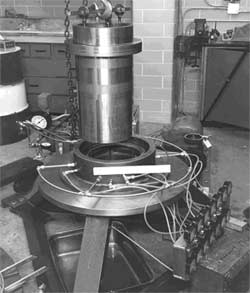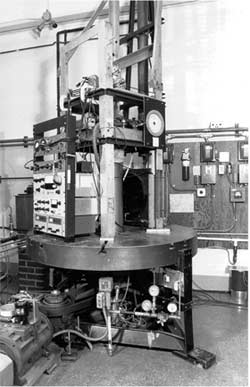



Russell J. Donnelly
541-346-4226 (Tel)
541-346-5861 (Fax)

![]() Superfluidity
of
Superfluidity
of ![]() He
He
Our group has been involved in superfluidity research for 50 years, spanning a wide range of experimental and theoretical topics. An early account of the subject is contained in:
Experimental Superfluidity, R. J. Donnelly, W. I. Glaberson and P. E. Parks. Chicago, University of Chicago Press (1967).
Equations of motion for helium II.
The first two fluid equations of motion for helium II were formulated by Tisza, and later by Landau. One of the questions was whether these equations would satisfy modern ideas of rational mechanics. This problem was taken up by Hills and Roberts and a review article on their findings and related matters appeared in Annual Review of Fluid Mechanics:
"Superfluid Mechanics", P. H. Roberts and R. J. Donnelly. Ann. Rev. Fluid Mech. 6: 179-225 (1974).
and considerably later, an update appeared in the same series:
"Quantized Vortices and Turbulence in Helium II", R. J. Donnelly.Annual Review of Fluid Mechanics 25 327-371 (1993).
The problem of the applicability of the equations of motion including mutual friction was taken up by Hall and Vinen in the 1950’s and later by Bekarevich and Khalatnikov. These are known as the HVBK equations. We know these are applicable at least for Reynolds numbers below 400 because of the success on predicting the instability of Taylor-Couette flow of helium II. The question of the applicability of these equations to turbulent flows has been receiving considerable attention recently. One example is a review article in JLTP:
"Emerging Issues in Helium Turbulence", C. F. Barenghi, C. J. Swanson and R. J. Donnelly. J. Low Temp. Phys 100: 1-29 (1995).
and a further review in honor of Joe Vinen outlines much of the history of turbulence in superfluid helium:
"Cryogenic Fluid Dynamics (Review article in honor of W.F. Vinen)", R. J. Donnelly. J. Phys. Cond. Matter 11: 7783-7834 (1999).
Rotons
These enigmatic excitations from the condensate have been the subject of years of research. They remain enigmatic.
Relevant papers include:
"Scattering and Binding of Rotons", P. H. Roberts and R. J. Donnelly. J. Low Temp. Phys 15: 1-27 (1974).
"Bound States of Rotons to Impurities in HeII", P. H. Roberts, R. W. Walden and R. J. Donnelly. J. Low Temp. Phys 31: 389-408 (1978).
"Dielectric Model of Roton Interactions in Dilute Solutions of 3He and 4He", R. J. Donnelly, R. W. Walden and P. H. Roberts. J. Low Temp. Phys 31: 375-387 (1978).
A recent review on the subject has appeared in Physics World:
"Rotons: A Low Temperature Puzzle" R. J. Donnelly Physics World:25-30 (February, 1997).
Quantized Vortices
This is an enormous subject and is best understood by means of a book on the subject
Quantized Vortices in Helium II, R. J. Donnelly. Cambridge, Cambridge University Press, ISBN 0-521-32400-9,346 pp,(1991).
For more recent progress on quantized vortex dynamics and superfluid turbulence, the reader might consult Cryogenic Fluid Mechanics at this site and :
Quantized Vortex Dynamics and Superfluid Turbulence: (Proceedings of a Workshop held at the Isaac Newton Mathematical Institute, August 2000), C. F. Barenghi, R. J. Donnelly and W. F. Vinen: Ed., Springer (2001).
"Background on Superfluid Turbulence", R. J. Donnelly. in “IUTAM Symposium on Reynolds Number Scaling in Turbulent Flow” A. J. Smits Ed., Kluwer Academic Publishers, Dordecht (2004), and the following two chapters by Vinen and Barenghi.
Rotating Helium II
A
great deal of research on vortex lines required the use of rotating liquid
helium.
While it is possible to put rotating shafts into cryostats, it is very
much easier to put the entire experiment on a large rotating table, and
bring out leads through slip rings. We built a large rotating table at
Chicago using an externally pressurized hydrodynamic bearing.
![]()

This device has been used not only for helium II but for many classical hydrodynamic experiments where Coriolis forces matter as well. The next picture shows it in use to study quantum turbulence experiments at the University of Oregon.
![]()

![]()
